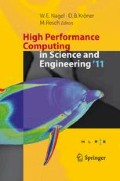Abstract
During a severe accident of a light-water reactor, hydrogen can be produced by a chemical reaction between the Zircaloy cladding and water and escape into the containment through a leak in the primary circuit. The prediction of the mass transport of hydrogen is vital for an optimised positioning of countermeasures like recombiners. It is possible that a stable stratification of hydrogen and air occurs, due to the different densities of those fluids. This stratification can be mixed with a free jet. This mixing is characterised by the time dependency of the flow, sharp velocity and density gradients as well as the non-isotropy of Reynolds stresses and turbulent mass fluxes.
With the use of a Reynolds stress turbulence model, the non-isotropic Reynolds stresses can be simulated. A similar approach is theoretically possible for the turbulent mass fluxes, but only the isotropic eddy diffusivity model is currently available in state-of-the-art cfd-software.
The shortcomings of the eddy diffusivity model to simulate the turbulent mass flux are investigated, as well as improvements with the use of a non-isotropic model. Because of the difficulties to get experimental data of flows in real containments, the THAI experimental facility was created to get experimental data for flows in large buildings. The experiments are performed by Becker Technologies. The analysis is using the experimental data of the THAI experiments TH-18, TH-20, TH-21 and TH-22 as the reference case. For safety reasons the used light gas for the TH-20 experiment is helium instead of hydrogen. Due to the rotational symmetry of the geometry as well as the boundary conditions, two-dimensional simulations are performed where applicable. The grids have been built following the best practice guidelines to ensure sufficient grid quality. Several simulations were carried out to investigate the numerical error caused by spatial and time discretisation.
During this reports time frame, simulations of the TH-20 and TH-22 experiments have been performed.
Access this chapter
Tax calculation will be finalised at checkout
Purchases are for personal use only
Preview
Unable to display preview. Download preview PDF.
References
H.-J. Allelein, S. Arndt, W. Klein-Hes̈ling, S. Schwarz, C. Spengler and G. Weber: “COCOSYS: Status of development and validation of the German containment code system”, Nuclear Engineering and Design, vol. 238, pp. 872–889, 2008
H.-J. Allelein, K. Neu and J.P. Van Dorsselaere: “European validation of the integral code ASTEC (EVITA) first experience in validation and plant sequence calculations”, Nuclear Engineering and Design, vol. 235, pp. 285–308, 2005
I. Kljenak, M. Babic, B. Mavko and I. Bajsic: “Modelling of containment atmosphere mixing and stratification experiment using a CFD approach”, Nuclear Engineering and Design, vol. 236, pp. 1682–1692, 2006
M. Houkema, N.B. Siccama, J.A. Lycklama and E.M.J. Komen: “Validation of the CFX4 CFD code for containment thermal-hydraulics”, Nuclear Engineering and Design, vol. 238, pp. 590–599, 2008
“International Standard Problem ISP-47 on containment thermal hydraulics final report”, Nuclear Energy Agency, NEA/CSNI/R(2007)10
T. Kanzleiter, A. Kühnel, K. Fischer, M. Heitsch and B. Schramm: “Technical Report THAI Blower Test TH 20”, Report No. 150 1325 TH20, Gesellschaft für Reaktorsicherheit, Köln, 2007
H. Siekmann and P. Thamsen: “Strömungslehre”, vol. 2, Springer, Berlin, 2008
W. Rodi: “Turbulence Models and Their Application in Hydraulics, A State-of-the-art Review”, vol 3, A.A. Balkema, Rotterdam, 1993
D. Wilcox: Turbulence Modelling for CFD, vol. 2, DCW Industries, USA, 2004
W.P. Jones and D. Lentini: “A realisable non-linear eddy viscosity/diffusivity model for confined swirling flows”, International Journal of Heat and Fluid Flow, 2008
F. Menter: “Two-equation eddy-viscosity turbulence models for engineering applications”, AIAA Journal, vol. 32, pp. 1598–1605, 1994
E. Laurien and T. Wintterle: “On the numerical simulation of flow and heat transfer within the fuel-assembly of the high-performance light-water-reactor”, Proceedings of the KTH-Workshop on Modelling and Measurements of Two-Phase Flows and Heat Transfer in Nuclear Fuel Assemblies, 200l
C. Speziale, S. Sarkar and T. Gatski: “Modelling the pressure-strain correlation of turbulence: an invariant dynamical systems approach”, Journal of Fluid Mechanics, vol. 227, pp. 245–272, 1991
ANSYS CFX User Documentation
Author information
Authors and Affiliations
Corresponding author
Editor information
Editors and Affiliations
Rights and permissions
Copyright information
© 2012 Springer-Verlag Berlin Heidelberg
About this paper
Cite this paper
Zirkel, A., Laurien, E. (2012). Turbulence Modelling for CFD-Methods for Containment Flows. In: Nagel, W., Kröner, D., Resch, M. (eds) High Performance Computing in Science and Engineering '11. Springer, Berlin, Heidelberg. https://doi.org/10.1007/978-3-642-23869-7_33
Download citation
DOI: https://doi.org/10.1007/978-3-642-23869-7_33
Publisher Name: Springer, Berlin, Heidelberg
Print ISBN: 978-3-642-23868-0
Online ISBN: 978-3-642-23869-7
eBook Packages: Mathematics and StatisticsMathematics and Statistics (R0)

